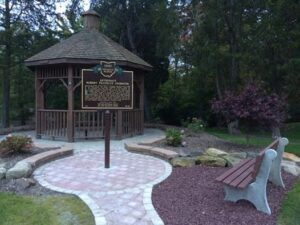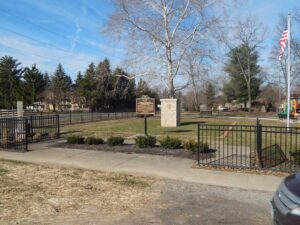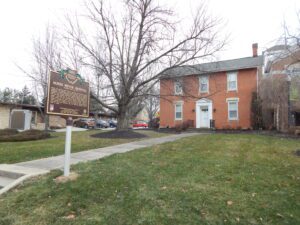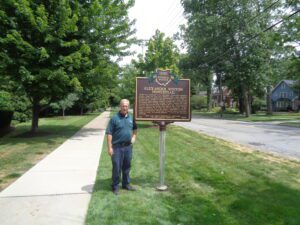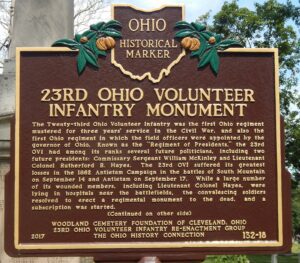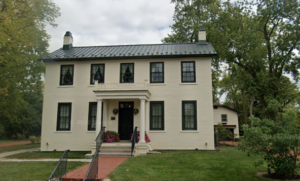, OH
Marine Colonel Robert F. Overmyer was born July 14, 1936 in Lorain, but always considered Westlake, where his family had lived since 1941, to be his hometown. He graduated from Westlake High School in 1954. After earning a bachelor’s degree in physics from Baldwin Wallace College in 1957, he entered active duty in the Marine Corps in 1958. He completed Navy flight training and was assigned to Marine Attack Squadron 214 in 1959. Overmyer logged over 7,500 flight hours, with more than 6,000 of those in jet aircraft. After earning a master’s degree in aeronautics from the U.S. Naval Postgraduate School in 1964, he was chosen as an astronaut for the USAF Manned Orbiting Laboratory Program in 1966. (Continued on other side)
, OH
The first Blendon Presbyterian Church was located at the intersection of Dempsey and Hempstead Roads on what is part of Blendon Central Cemetery. Timothy Lee (1785-1862) donated land at the northeast corner for a church and cemetery. The church was dedicated on December 6, 1829, but it burned that same night under suspicious circumstances. Following the fire, the congregation’s members built another edifice on “Phelps Acre,” across Hempstead Road and so named for benefactor Edward Phelps. Sr. (1759-1840). The congregation held services there from 1830 to 1865. It was believed that the church was finally abandoned and dismantled piecemeal after the Central College Presbyterian Church was finished in 1870.
, OH
The house at this location, 110 South State Street, was the childhood home of Agnes Meyer Driscoll (1889-1971). Known as “the first lady of naval cryptology,” her career spanned from World War I to the Cold War. Driscoll attended Otterbein University before graduating from the Ohio State University, with majors in physics, math, music, and foreign languages. During World War I, she enlisted in the U.S. Navy as a chief yeoman, the highest rank possible for a woman at the time. After the war, Driscoll rose to become the chief civilian cryptanalyst for the U.S. Navy, breaking major Imperial Japanese Navy codes prior to World War II. (Continued on other side)
, OH
On this site, Alexander Winton (1860-1932), an American automobile pioneer, built and lived in a lakefront estate named Roseneath. Winton was born in Scotland and immigrated to the United States as a young man, settling in Cleveland. In the early 1890s, Winton founded the Winton Bicycle Company; six years later, he incorporated the Winton Motor Carriage Company. In 1903, Winton’s auto plant on Berea Road was one of the largest in the world, and he produced the first car to cross America from coast to coast. These business successes enabled him to build the 25-room Roseneath. In 1912, Winton founded the Winton Gas Engine & Manufacturing Company, which would eventually become part of General Motors Corporation. Winton is buried in Lakeview Cemetery. A fire in 1962 destroyed Roseneath.
, OH
The Twenty-third Ohio Volunteer Infantry was the first Ohio regiment mustered for three years’ service in the Civil War, and also the first Ohio regiment in which the field officers were appointed by the governor of Ohio. Known as the “Regiment of Presidents,” the 23rd OVI had among its ranks several future politicians, including two future presidents: Commissary Sergeant William McKinley and Lieutenant Colonel Rutherford B. Hayes. The 23rd OVI suffered its greatest losses in the 1862 Antietam Campaign in the battles of South Mountain on September 14 and Antietam on September 17. While a large number of its wounded members, including Lieutenant Colonel Hayes, were lying in hospitals near the battlefields, the convalescing soldiers resolved to erect a regimental monument to the dead, and a subscription was started. (Continued on other side)
, OH
Hugh Grant Sr. (1769-1806) owned a gristmill and land in Pittsburgh, Pennsylvania, during the 1790s. He married Catharine Barr Grant (unknown-1836) and they had 6 children: Alexander, Jacob, Isabella, Nancy, Mary, and Hugh Grant Jr. (born posthumously). In 1804 Grant purchased 450 acres of federal land at the Chillicothe land office. In 1805 he and his family moved to Jackson Township, Ohio. Uncertain of the location of his tracts, he settled his family in a log structure along the Scioto River. During the winter of 1806-1807, Grant died in a freak accident climbing a honeybee tree. Catharine Barr Grant realized they were on the wrong land and moved her family to the right property holdings where the Grant Homestead remains. She died August 17, 1836, and is buried in Union Methodist Cemetery.
, OH
Bounded by Ridge, Royalton, and Bennett Roads, the Green has been the heart of North Royalton even before it was incorporated. Once part of Brecksville Township, Royalton became its own township in 1818. Local lore says that settlers David and Knight Sprague paid a gallon of whiskey to name the community after their hometown of Royalton, Vermont. In 1825, John Watkins sold five acres to create this Green, so that the township could have a cemetery, a public square, and a place for public buildings. In 1885, “North” was added to “Royalton” to distinguish it from another Royalton in Ohio. Formerly a small agricultural community known for milk and cheese production, as well as nurseries, North Royalton became a Cleveland suburb following World War II. North Royalton incorporated as a village in 1927 and became city in 1961. (Continued on other side)
, OH
The cemetery has been the final resting place of area residents since the 1820s. Settlers from New York and New England migrated here in the 1810s and 1820s. First called “Greenbrier,” the area took the name Parma after the township was organized in 1826. A log building at the cemetery’s north end stood from 1826 to 1841 and served as a township school, public meeting place, and church. The cemetery’s small sandstone vault was erected in 1892. After voters established Parma Heights village in 1911, the Parma Heights Cemetery Improvement Association formed to care for the grounds. (Continued on other side)


